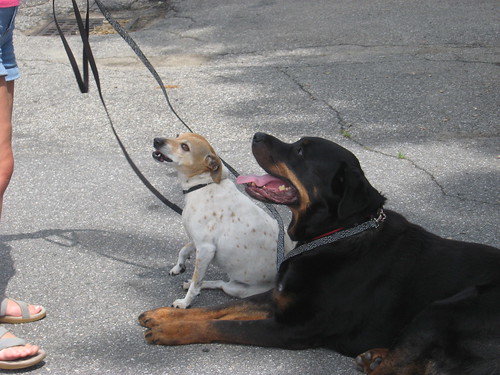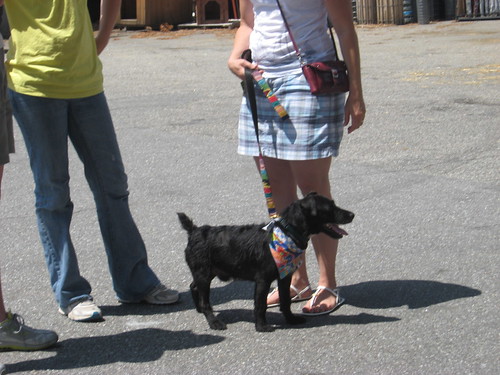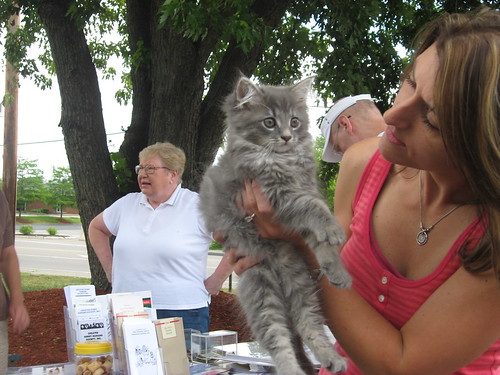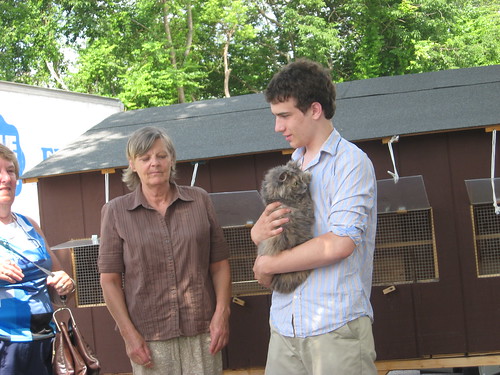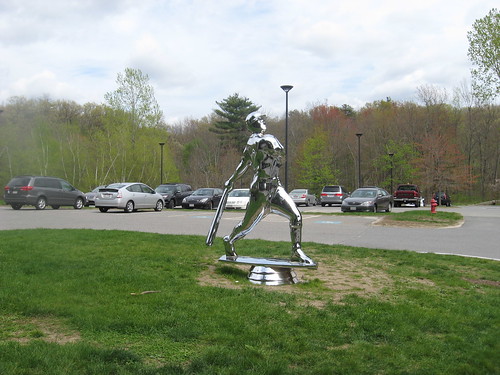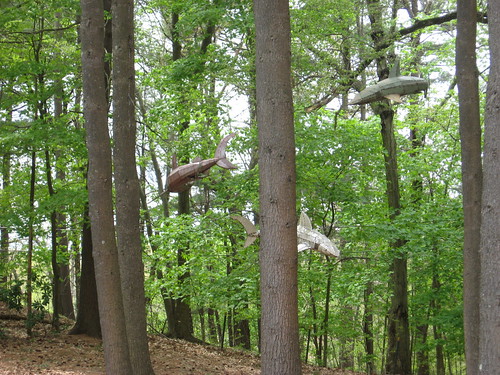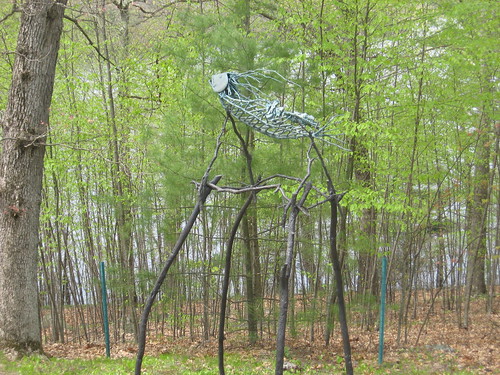Thursday, December 30, 2010
Deep State, by Walter Jon Williams---Review
Dagmar Shaw is running an Augmented Reality Game, an ARG, in Turkey to promote the latest James Bond film, Stunrunner. She's not happy about being in Turkey, where a military junta has recently seized power, because she's had some seriously unpleasant experiences with military governments in the past, but, really, what can go wrong? Turkey is benefiting from the positive PR and the increase in tourism, and the generals are very pleased by that. Her company, Great Big Idea, is being very well paid by the movie promoters.
And then Dagmar and some of her people are invited to meet the generals, and Dagmar accidentally offends the head of the junta, General Bozbeyli.
Dagmar, her immediate boss Lincoln, and her top on-site American and Turkish employees, have to evade the junta while staging the last live event of the ARG--and that means moving the live event at very short notice. Dagmar and her team work out a way to do it, wrap up the game, and head home.
But before she leaves, Lincoln offers her a new job. Lincoln, it turns out, works for the US government and is in Special Ops. The current Turkish junta, unlike previous ones, is not interested in restoring a secular state and then turning the government back to democracy; they're in it for the money. Lincoln wants to use Dagmar's game-running skills to peacefully destabilize the current Turkish regime and force a return to democracy.
Working from a British military base on Cyprus, Dagmar and her team--Turks Ismet, Tuna, and Refet; Americans Judy, Lloyd, Lola, Magnus, and Byron--set to work, running an Augmented Reality Game with the very real-world goal of bringing down a government. Flash crowds form in places where it's hard for the police to respond quickly, and melt away before they can react. They wear scarves, carry towels, postcards, DVDs, flowers--things that look like they have meaning but really only have the purpose of identifying participants in the flash crowds. It's all going well, and the regime is looking more and more foolish and impotent.
Then demonstrations start that aren't planned by Dagmar and her crew, and the astroturf revolution is becoming a genuinely grassroots one, and shortly after that, the regime feels threatened enough to deploy a secret weapon that Lincoln helped create, years earlier--the High Zap. It allows the power that has it to selectively take down the internet--in fact, anything that relies on TCP/IP protocols--and Turkey has it because two agents were deployed to use it against Syria right before the Turkish coup, and the generals wound up in possession of the laptop containing it.
Dagmar and her friends find themselves in a wild contest to survive, defeat the High Zap which now threatens the economic stability of the world, and maybe even achieve their original goal, as some of them are killed, some revealed to be traitors, and Lincoln and their government resources and status are pulled because Lincoln's plan has gone so badly wrong.
It's an exciting mix of spy thriller, adventure, and romance, and as is typical of Williams, it's all extremely well-done.
Highly recommended.
I received a free electronic galley of this book from the publisher via NetGalley.
Saturday, December 11, 2010
Against the Fire (The Raines of Wind Canyon), by Kat Martin--Review
Publication date 01/25/2011
The is the second book in the Raines brothers trilogy, and it's the second brother, Gabriel Raines's turn. He's built a successful construction business, and life is looking good until someone starts torching his construction sites.
After the first fire, the police quickly pick up a young man seen near the fire, Angel Ramirez. He had a previous arson conviction, but his family has been getting help from the Family Resource Center, and he's become a hardworking, well-behaved high school student. Mattie Baker, a rising young architect and also an active supporter of the Family Resource Center, visits Angel at the police station, meets Gabe--and convinces him to keep an open mind about Angel, and look for other, more likely, possibilities.
Gabe listens to Mattie mostly because she makes cogent arguments and is completely sincere, but there's no denying he's attracted to her--and she to him. This unacknowledged mix of motives is behind their decision to begin their own investigation in parallel with the official investigation, and when the police quickly uncover evidence that an unusual accelerant was used, and was purchased by a man who looked nothing like Angel, the young man decides that he's going to help, too. Mattie and Gabe tell him to take no chances, to ask no questions, just keep his eyes and ears open, but of course he feels the need to do more than that. The wrong person notices, and hits Angel on the head from behind, landing him in the hospital, in a coma.
The attack on Angel heightens the sense of danger, as do the subsequent fires at other Raines Construction projects, and, for Mattie, mysterious hang-up calls she's getting, which she does not tell Gabe about. As the investigation throws them together, and their mutual attraction draws them together, they are pushed apart by Mattie's fear of relying on anyone other than herself. That fear was created by her father's early death, leaving her mother and herself in poverty, and compounded by a previous romantic involvement that ended very painfully. In counterpoint to Gabe and Mattie's courtship is the courtship of Gabe's friend Sam and Mattie's friend Tracy, who has her own very different yet equally painful issues making it difficult for her to commit to a relationship. Each woman, of course, can see the ways the other woman is frustrating her own happiness.
As the fires continue and threaten Gabe's business, red herrings and confusing clues confound both the official and the unofficial investigations while an unbalanced but very clever and vengeful killer draws closer and closer. Whether or not Mattie and Gabe can find their way to true love will be moot if they don't find the killer before the killer catches up with them.
A good, satisfying read.
Note: I received a free electronic galley from the publisher via NetGalley
Wednesday, December 1, 2010
Strangers, by Mary Anna Evans--Book Review
Publication date 10/01/2010
This is Evans' sixth novel about archeologist Faye Longchamp and her husband Joe Wolf Mantooth. I haven't read any of the others, and didn't find it an obstacle to following and enjoying this story. Faye has turned her archeology degree into a business rather than a tenure-track teaching position, and she, Joe, and their employees, including Magda Stockard-McKenzie, Ph.D., are in St. Augustine, FL, excavating the back yard of the Art Deco-era mansion, Dunkirk Manor, whose current owners want to add a swimming pool. Dunkirk Manor is in a historically rather uninteresting section of St. Augustine, and it'a a relatively easy assignment, perfect for the last month or so of Faye's pregnancy. An unexpected bonus is the discovery, in a storeroom, of the journal of a priest, Father Domingo, who accompanied the first Spanish expedition to the St. Augustine area.
Or so it seems, at least until Glynis Smithson, assistant to the owners, Daniel and Suzanne Wrather, disappears. Her car is parked out back, there's some blood in her car and a lot more just outside it--and if there was any trail of blood leading away from the car, it has possibly been washed away by the automatic sprinklers. There are also a few odd items in and near the car, artifacts apparently dating to the 16th-century arrival of the Spanish.
Faye becomes involved in the investigation into Glynis's disappearance, which becomes a murder investigation when her boyfriend turns up dead, because of the archeological connection. At the same time, the excavation at Dunkirk Manor becomes more interesting, as they uncover evidence of a previous swimming pool, as well as buried 1920s-era children's toys in what looks very like a small shrine. As Faye learns more about both her employers and the 1920s owners, she discovers an unsolved murder of a beautiful starlet, and an odd parallel between Suzanne and her great-aunt Allyce Dunkirk, in that they both lost very young children whom they continued to mourn many years later. The archeological items and the fact that her boyfriend was murdered leads to the suspicion that Glynis was murdered or kidnapped because she discovered a construction project going forward illegally after discovering an unreported archeological site.
Faye divides her attention amongst the Dunkirk Manor dig, Father Domingo's journal, the unsolved murder, and Glynis's disappearance, and they all tangle together in unexpected ways. And when she gets too close to some of the answers, the situation turns dangerous, and she's fighting for her life against an unexpected villain.
I found Strangers engrossing and highly readable, and I'll probably be looking for more of Evans's books about Faye.
Saturday, November 13, 2010
The Janus Stone: A Ruth Galloway Mystery, by Elly Griffiths--Review
Forensic archeologist Ruth Galloway is settling back into normal after the unsettling events of a few months ago when she gets a call from the head of the university archeology department. Construction workers on the site of an old house in Norwich that previously served as a children's home have found the bones of a young child. The bones need to be identified, and it needs to be determined as quickly as possible if this is an archeological find or a crime scene. Knowing the police need to be involved, Ruth calls Detective Chief Inspector Harry Nelson, whom she's worked with in the past.
What she hasn't yet told Nelson, who is married and has two teenage daughters, is that she's pregnant as a result of their one night of "We Didn't Get Killed" sex four months ago.
As they piece together the evidence and determine that they have the body of a young girl, they also learn that two children disappeared from the children's home in the early 1970s--and that one of them was a girl about the age of the child whose bones they have. And in the mid-1950s, the young daughter of the family living there at the time, when it was still a private home, also died at the right age--supposedly of scarlet fever.
Meanwhile, another archeologist, Max Gray, working on a site in Swaffham, is showing a friendly and possibly more than friendly interest in Ruth. Ruth is interested, but does she need the complications? Will he still be interested when he knows she's pregnant?
While she's juggling all these problems and complications, alarming things start to happen around Ruth. Someone sacrifices a cockerel and writes her name in blood at the Swaffham site. She hears someone breathing nearby when she's out in the dark, and stumbles and passes out when she sees what appears to be a dead baby--and turns out to to be a model from a museum exhibit.
The tension develops nicely, and the mystery is satisfyingly complex and interesting. This is the second of the series, and some things, such as Ruth's pregnancy and the relationships among some of the characters, are products of the events of the earlier book, The Crossing Places. However, since I have not read it, I can feel completely confident in saying that this book stands on its own sufficiently to be a satisfying, enjoyable read.
Strongly recommended.
Note:: I received a free electronic galley from the publisher via NetGalley
Tuesday, November 9, 2010
Advent of a Mystery, by Marilyn Leach--Review
Berdie Elliott is a former investigative reporter, and the wife of the new vicar of Aiden Kirkwood. This is a new calling for Hugh, after a military career, and Berdie has retired from her own career to be the vicar's wife. But she hasn't given up her skills or her active mind, and when an elderly parishioner, Miriam Livingston, is murdered in her home after an evening of caroling and an Advent party at the vicarage, Berdie can't help looking into things. Especially when the village constable is willfully blind to anything but the most obvious evidence, and locks up the most immediately obvious suspect, Jamie Donovan, who quarreled with Miriam Livingston at the party, and whose engraved screwdriver was found near the victim's body and had clearly been used as the murder weapon.
Hugh wants Berdie to stay out of it, to avoid risks both to her own safety and to their still-new status in the village. Both her professional instincts and her sense of justice draw her in, though, and Hugh also can't remain opposed. Too many things don't add up, and Berdie, with her friend Lillie in tow, keeps digging. When they discover that Miriam Livingston is someone other than whom the village has always believed her to be, things start to spiral out of control and the dangers to Berdie that had worried Hugh from the beginning begin to materialize.
This is a really engaging "cozy" mystery, with likable and interesting characters. I hope we'll be seeing more of Berdie and her friends and neighbors.
Recommended.
Against the Wind (The Raines of Wind Canyon), by Kat Martin--Review
Sarah Allen, finally freed from an abusive marriage by the unsolved murder of her husband, gathers up her young daughter and the few possessions left to her after everything is sold to pay her husband's debts, and returns to her childhood home of Wind Canyon, Wyoming. She's rented a small house on the property of one of the local ranches, and landed a job with the local newspaper,. She'll finally be putting her journalism degree to some use, and as a bonus she'll be living near enough to visit her last surviving relative, her grandmother.
But Sarah's troubles aren't over yet. She's getting calls from a former business associate of her husbands, who is quite certain that Sarah knows where Andrew kept a disk or flash drive with some vital information. And the owner of the ranch she's moved onto is Jackson Raines, whom Sarah yearned for and spurned in high school. Sarah and Jackson resist their mutual attraction while the calls get more threatening--but when the calls progress to the trashing of Sarah's cottage and her grandmother's home, she has no one to turn to but Jackson.
Trouble keeps closing in on them, as the FBI threatens Sarah with charges to force her to give information she doesn't have about Andrew's business activities, and his former associates get more violent in their pursuit of that flash drive. And there's still one secret Sarah is keeping from Jackson, something she knows will kill his growing love for her.
This is a well-written romance with interesting, likable characters, and the added bonus that no one does anything stupid or creates a willfully stupid misunderstanding in order to create necessary plot complications. Sarah's secret reason for pulling back is real and serious, and Jackson reacts like an adult, not an over-reactive teenager. These are solid adult characters, well worth the time spent with them.
Recommended
Thursday, November 4, 2010
God Soul Mind Brain: A Neuroscientist's Reflections on the Spirit World, by Michael S. Graziano
Thursday, October 28, 2010
Don't Be Such a Scientist: Talking Substance in an Age of Style, by Randy Olson---Review

Randy Olson is a marine biologist who did his research, did his publishing, and became a tenured professor at the University of New Hampshire.
And then he resigned to become a filmmaker.
In Don't Be Such a Scientist, Olson talks about his own journey from scientist to science filmmaker, and explores the problems of communicating science to a broad audience. He finds the problems to lie mainly in a disconnect between how scientists learn to communicate with each other and the kinds of communication that work with the general, non-scientist public, and especially what does and does not work in the mass media.
Scientists place the highest value on accuracy; they correct inaccuracies, they question assumptions, they demand evidence. This is all vital to what scientists do; without these behaviors, real advances in knowledge can't happen. But when scientists use those same behaviors when talking to the general public, and especially when speaking on tv or making films and videos intended to reach the general public, these same behaviors come across as negative, argumentative, and unlikeable. Scientists, Olson says, work almost entirely in their heads, while reaching a broad audience--even getting the attention of a broad audience, due to how inundated we are with information--requires reaching the heart, the gut, and even, as he delicately phrases it, "the lower organs."
To illustrate the impact of an over-emphasis on being serious and relentlessly accurate, vs. presenting the information with style, heart, and even humor, he compares the reception given to two 2006 movies about global warming--HBO's April 2006 Too Hot Not Too Handle, and Al Gore's May 2006 An Inconvenient Truth. The first, he says, was "solid, relatively impersonal, objective effort featuring interviews with many top scientists." The second is a personal narrative by Al Gore, featuring his stories of long-term involvement with the issue, the tragedies involving his sister and his son, some humor, along with lots of substance. With all the emphasis on style, Gore nevertheless used PowerPoint graphs in abundance to communicate facts and data.
The HBO movie was completely accurate--but also boring and depressing. It sunk without a trace. Gore's was filled with important information, but had some inaccuracies that would never have survived in the HBO effort. But none of those errors were important enough to undermine the central point--and An Inconvenient Truth was a huge hit, and won both an Oscar and a Nobel Prize. Which was more effective in getting real knowledge of global warming to the general public?
Some of the entertaining stories Olson has to tell include his own collision with acting class (news flash: scientists are not naturals at just going with their feelings), the struggles to make his own 2006 film on evolution vs. "intelligent design," Flock of Dodos, watchable--and then the reaction of science bloggers to a movie that still wasn't accessible enough for distributors to want it for general audiences.
I'm not doing justice to the book, but it's short, pithy, and completely readable, along with providing ample food for thought on how to communicate science to the general public.
Important note: I received a free electronic galley of this book from the publisher, Island Press.
Thursday, September 16, 2010
My adventures in ebooks
As for dedicated ebook readers... One is from Sony. After the rootkit nonsense of a few years ago, I'll never trust a Sony device again. Some of my friends have Kindles, and they love them. I've looked at them, held them--and not loved them. Not hated--just, not loved them. I suspect that if I traveled a lot, and carrying enough reading material on planes and trains were therefore an issue for me, I'd probably have succumbed. But I don't, so I didn't.
Then this summer my mother decided she wanted an ebook reader, or was convinced by my sister that she did, so that she could check books out of the library without having to leave her apartment on the days when she's less than fully mobile. She wanted to go look at ereaders, and asked me to come with her. We wound up at Barnes and Noble, looking at the Nook. Excuse me, the nook. B&N favors the lower-case n for the name of their device.
What can I say? I fell in love. It's the right size. The display is nice, e-ink really is almost like reading a printed page, far better than a typical computer screen display. It's about the weight of a trade paperback, and a bit smaller in dimensions--even with the optional but highly recommended case/cover. The battery life is more than decent, in part because the nook uses power only when changing something (such as turning a page), the touchscreen portion is active, or you're using the wi-fi or 3G capabilities. About once a week, I need to plug it in for a few hours, and the rest of the time, I don't have to worry about it at all.
It's easy to adjust the size of the text to what's comfortable for you, and I do find that on the nook screen I prefer a larger text size than I would like on the printed page. I've also loaded on a few pictures of my dog to serve as my screensaver; it's easy to do, and fun to see her cute face every time I pick it up. Once you've got the book you're reading open, and the control touchscreen at the bottom goes dark, you can turn pages by swiping a finger over the darkened touchscreen. It's about as close to reading a print book as an electronic device can probably achieve.
Of course, if you spend the money on a ebook device, you're not only concerned about ease of use. You're also concerned about availability of material. Overall, ebook prices are closer to paperback prices than to hardcover prices, but that's not universally true. The sad truth is that many publishers are so afraid of piracy that they make ebooks expensive and load them down with DRM (digital rights management) that makes them hard to use conveniently--and of course impossible to lend.
However, I'm finding more than enough that's available at close-to-paperback cost that I don't feel unduly restricted in my reading choices. Barnes & Noble also offers some free ebooks; so does Amazon for the Kindle. B&N, unlike Amazon, does allow "lending" of ebooks bought from them--if the publisher agrees. It's very restricted (only for two weeks, and any given book can only be lent once), but it's a beginning. When the publishers realize that this is not hurting but rather helping their sales, I'm sure it will expand.
You can borrow ebooks from your public library, too (remember, this is where we started, with my mother's desire to do so.) What and how much is available this way will depend on what library or libraries you belong to, and what consortia they belong to, but if you are open in your reading choices, you may find that there's plenty of reading material available.
There are also other sources of free ebooks. At Manybooks.net, there are many older classics and older forgotten-but-excellent books available, out of copyright protection and unburdened by DRM. Some authors offer some of their own books as free or inexpensive ebooks, and some publishers, in contrast to the publishers who are terrified of the digital age, do the same with older titles. If you are a science fiction reader Baen Books is an excellent source of free sf, and you should also check out their ebook store for more current titles, not free of course, but not expensive if they're the books you want.
I'm enjoying my nook, and I think I will continue to do so.
Oh, and my mother? She wound up buying a netbook, instead, which makes sense for her needs. She had no computer at all, and library ebooks need to be downloaded to your computer first and then transferred to your ereader device, so the nook, or the Kindle, or the Sony reader, alone, wouldn't have helped her. She also wanted email access. Her netbook isn't much bigger than the nook, and it does the other things she needs. Less battery life, of course, but since the whole point is that she wanted something that would allow her to not go out when she wasn't feeling up to it, that's not really a issue. She can curl up and read with this, and still keep it plugged in most of the time.
Do I think ebooks are going to replace print books? Not anytime soon, no. They're a nice additional option, though.
Tuesday, August 3, 2010
Pelham Adoption Day 7-24-10

Then we were off to the Pelham Adoption Day. Davey

and Sparky

and Capone
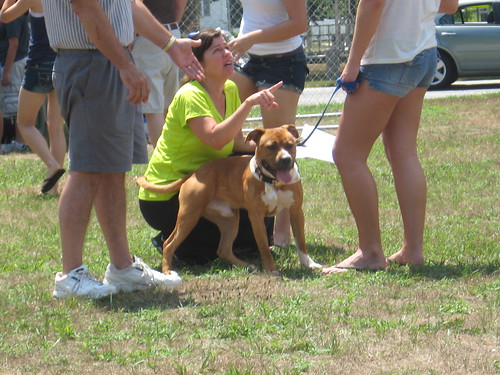
were among the dogs seeking new forever homes.
Addy helped staff the table:

ARNNE also brought this beautiful girl, Gracie:

Puppies, too! Although I didn't get this little guy's name:
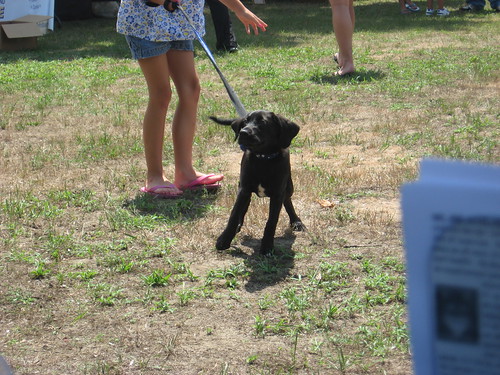
All in all, it was a lively, fun day, with wonderful, friendly dogs seeking their new forever homes. Don't miss the next one!
Thursday, July 22, 2010
Gucci Needs Your Help
Pet Oxygen Masks for Derry Fire Department
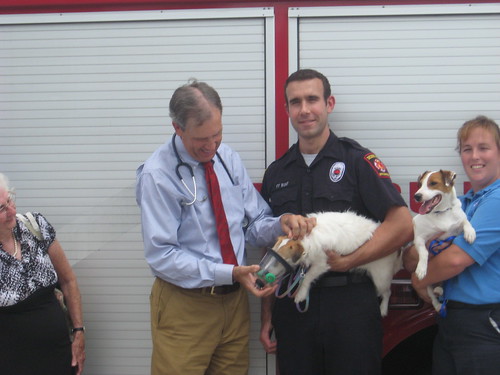
Zoey the Jack Russell Terrier demonstrates the use of the mask with the help of a Derry firefighter and Timothy J. Butterfield, DVM
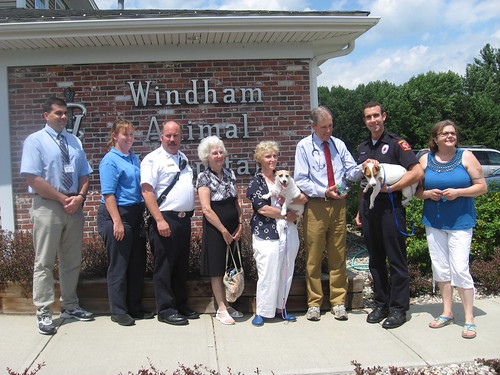
Barbara McCarthy, President of the Greater Derry Humane Society, Timothy J. Butterfield, DVM, Zoey and her brother Niles, and other members of the Greater Derry Humane Society, Windham Animal Hospital, and the Derry Fire Department
Dr. Butterfield did the research to identify the best pet oxygen masks to purchase, and Windham Animal Hospital donated several masks in three different sizes. With the masks being purchased and donated with funds raised by the Derry Public Library and others, pets in Derry will have a much greater chance of being rescued in the event of a fire in their homes.
Saturday, July 3, 2010
More Pet Food Recalls--Friday night dump & run recall anouncements
Saturday, June 19, 2010
Greater Derry Humane Society adoption events
Friday, May 14, 2010
The Kong Rocket--for your "mad about fetch" dog
Saturday, May 8, 2010
No good deed goes unpunished
Thursday, April 29, 2010
Facebook and online privacy
Sunday, April 25, 2010
DeCordova Sculpture Park--A Dog-Friendly Art Museum
Friday, April 16, 2010
Is Mother Nature annoyed with us?
Sunday, April 11, 2010
Chinook Dogs visit the Greater Derry Humane Society

Last Tuesday, two Chinook Dogs visited the monthly meeting of the Greater Derry Humane Society. The Chinook Dog is the state dog of New Hampshire, a recreational sled dog whose foundation stud, Chinook, accompanied Admiral Byrd to the South Pole.
Chinooks are medium to large dogs, 55 to 90 pounds, muscular, calm, non-aggressive, affectionate with family and generally reserved with strangers. In addition to sledding, they enjoy skijoring, dog agility, obedience, and search & rescue.

A neat giveaway at Two Little Cavaliers
Enjoy!
Wednesday, March 24, 2010
The Greater Derry Humane Society
Initially, I was involved only in another activity of GDHS--therapy pet visits to a local nursing home. My dog Addy and I enjoy these visits immensely, and Addy is developing her own little following at the nursing home.
But the main thing is finding homes for homeless animals, and one part of that is getting pictures up on Petfinder so that people looking for pets to adopt can find them. So yesterday, I took pictures of three worthy and deserving cats. Reecie and Angel's profiles are up on Petfinder and their names link to their pages; Domino's should appear soon.
Domino is a big, laid-back, huggable guy.
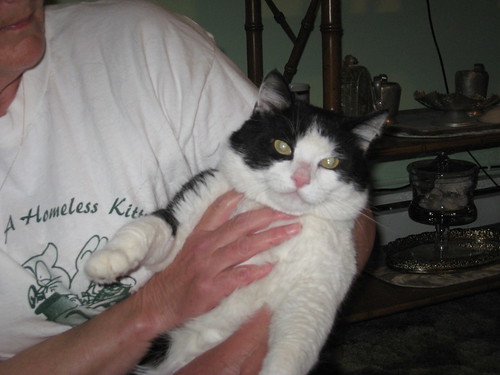
Angel is a sweet, beautiful girl.
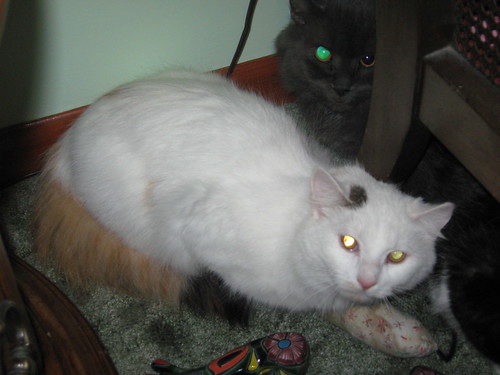
Reecie is another good-looking girl who seemed pretty calm despite her doubts about Addy standing beside me while I took the picture.
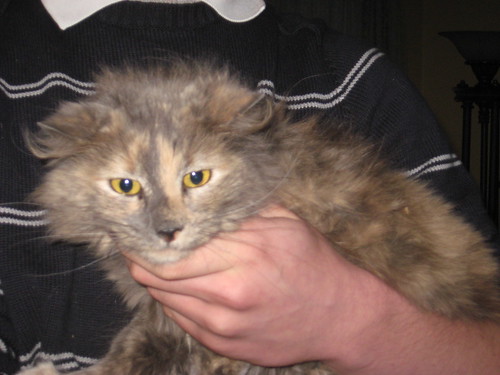
Contact the Greater Derry Humane Society if you're interested in meeting any of these lovely cats.
Thursday, March 11, 2010
USS Constitution Fires Away...
Tuesday, March 9, 2010
Bella the Future Service Dog
 Today, Addy and I visited our nursing home friends as part of our regular pet therapy visits, and as a bonus extra, we met Bella, a future service dog. She's a sweet, five-month-old black Lab, and like any young dog with a demanding career ahead of her, she needs lots of practice meeting all kinds of people, dogs, cats, and anyone and anything else she might encounter in the course of her work.
Today, Addy and I visited our nursing home friends as part of our regular pet therapy visits, and as a bonus extra, we met Bella, a future service dog. She's a sweet, five-month-old black Lab, and like any young dog with a demanding career ahead of her, she needs lots of practice meeting all kinds of people, dogs, cats, and anyone and anything else she might encounter in the course of her work.Tuesday, March 2, 2010
E-Books and Libraries
Thursday, February 25, 2010
Digital Complications
Google, of course, is trying to digitize the world and make it all available via their search engine. For Google Books, they've finally reached a deal--sort of--with the publishers, but the only protection offered for the content generators, i.e., the authors, is an opt-out clause, and not all of them are meekly going along:
http://www.wired.com/epicenter/2010/01/le-guin-joins-opposition-to-google-book-search-settlement/
The authors ought to have real control over their works and should not find that by signing a contract agreeing to the print publication of those works they have accidentally signed over electronic rights not mentioned in their contracts without additional compensation, and which potentially impairs the future salability of that work. Yet there are real benefits to the rest of the world in making published material available as widely as possible, and there is no question that online availability aids that. As the publishing world grows more accustomed to our new digital world, I would expect that the standard contract will be rewritten to include those online rights. If they do so without including additional compensation for the authors for that use, however, this will continue to be a battle.
The other interesting development in recent weeks was the showdown between Macmillan and Amazon. Macmillan wanted to restructure the way it sells e-books through Amazon, including raising the price on some books from $9.99 to $14.99. Amazon responded by suspending sale of every single title published by the entire Macmillan publishing conglomerate--not just e-books, but all print books as well:
http://www.boingboing.net/2010/01/29/amazon-and-macmillan.html
Now, Amazon caved after a couple of days and the books reappeared:
http://www.amazon.com/tag/kindle/forum/ref=cm_cd_tfp_ef_tft_tp?_encoding=UTF8&cdForum=Fx1D7SY3BVSESG&cdThread=Tx2MEGQWTNGIMHV&displayType=tagsDetail
But the fact remains that a huge quantity of material simply disappeared from the largest and most familiar source. Amazon was not an exclusive source for the print books, of course, but the same thing has happened with "exclusive" electronic content on subscription online services Lexis and Westlaw that is not published by those companies, as corporate entities negotiate, bid against each other, play hardball, etc. Content that was on one system moves to the other, or becomes temporarily unavailable. Corporations, law firms, and public and academic libraries with large enough budgets to have contracts with both suffer less disruption, though still some loss of efficiency, but the only people who can be sure they have uninterrupted access are those who have the print editions.
Both the Google Books story and the Amazon/Macmillan tussle demonstrate that the customer can all too easily wind up getting the short end of the stick.
For all the advantages of electronic access (and they are many), it is concentrating too much control in too few hands, and those hands belong to those whose primary obligation is to the financial health and competitive advantage of their employers, with no professional commitment to the continued and general availability of the content. As a librarian, I find that disturbing. It risks undermining our ability to be an educated, informed society.
Even at its best, electronic access nearly always means you are renting the information rather than buying it. That can be an appropriate choice--but it's important to know that you are doing it, and to make a conscious, thoughtful choice in that regard, and too often it is not.
News from our friends at Two Little Cavaliers
Tuesday, February 23, 2010
Annoying Ads
Toyota Sienna ads
This is the latest entry in that puzzling category, "buy our product so that you can be like these really annoying people you would cross the street to avoid." A husband and wife, who previously imagined themselves too good to drive anything as plebian as a minivan, have bought a Toyota Sienna, which is stylish and wonderful enough to almost equal their own style and wonderfulness. The hubby calls it "The Swagger Wagon." Of course, we all love people who swagger, right? The wife oozes smug satisfaction in having found a minivan that doesn't make her look middle class and married. She also uses the Sienna as a place to just hang out, doing her nails whatever else. When hubby is talking the words appear on the screen over him, "Daddy like." When the wife is talking, the words appear, "Mommy like."
Added bonus: These ads still brag about Toyota reliability. In the midst of a major recall which keeps getting bigger and bigger, when information is emerging that Toyota worked to limit earlier brake-related recalls, and they're still denying that there are any electrical problems despite customer reports.
Volkswagon "Punch Buggy" ads
There's a children's game, dating back to the 1960s, in which the children watch for Volkswagon Beetles, and when they spot one, call out "punch buggy!" or "slug bug!" and punch each other. Volkswagon has inexplicably decided to use a generalized version of the game in their latest ad campaign, with putative adults punching each other at the sight of any Volkswagon, calling out "red one!" or whatever color as they do so. So, okay, why do I want to be anywhere near people acting like that? As with the Toyota Sienna ads, if I'm going to be influenced in my car choice by ads like these, it's not going to be in favor of the cars featured in these ads. If other people's car choices are going to affect mine, I want to drive a vehicle favored by at least minimally rational adults, not by people likely to randomly punch me, or people whose main concern is whether the vehicle supports their egos.
Yes, I do get that these ads are supposed to be funny. The problem is that they are funny if you are somewhere between the ages of six and sixteen--and in most states, you can't even get a driver's license before the age of sixteen. Who do Toyota and Volkswagon think are making the buying decisions?
Saturday, February 20, 2010
Tiger Woods' Apology
He did not talk about the women he had the affairs with, or apologize to them or to their families, who were hurt by this just as his own wife has been hurt. And he did not take any questions.
Tiger has courted media attention for his entire career. He has made millions off of his squeaky clean image, even more than off of the fact that he's possibly the greatest golfer ever. But he has always wanted that media attention to be solely on his own terms. He has always wanted total control of the message. But now we have found out that a large part of that message was a lie--he is not the squeaky clean guy he has been selling to us--and he still wants to control the message.
Let me be clear. Tiger telling the media to back off his wife, his kids, and his mom is totally appropriate. I hope the media listen and heed, though I doubt they will. They are not the ones who made this Faustian bargain.
Tiger is. And Tiger Woods cannot seriously expect that saying "sorry, no questions" will be enough.








